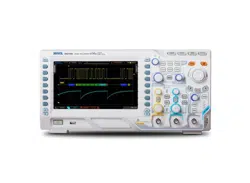Loading ...
Loading ...
Loading ...

Chapter 13 Signal Source RIGOL
MSO2000A/DS2000A User’s Guide 13-11
3. Set the amplitude
Press Amp to set the amplitude of the signal. When the impedance is set to
HighZ, the range is from 20 mVpp to 5 Vpp; when the impedance is set to 50 Ω,
the range is from 10 mVpp to 2.5 Vpp. For the setting method, please refer to
the introduction in “
Parameter Setting Method”.
4. Set the DC offset voltage
Press Offset to set the DC offset of the signal. When the impedance is HighZ,
the range is from (-2.5 V + the current amplitude/ 2) to (2.5 V - the current
amplitude/2); when the impedance is set to 50 Ω, the range is from (-1.25 V +
the current amplitude/ 2) to (1.25 V - the current amplitude/ 2). For the setting
method, please refer to the introduction in “
Parameter Setting Method”.
Note: The offset value only contains three effective digits. For example, when
the amplitude is set to 30 mVpp (the impedance is 50 Ω), the offset range
calculated is from -1.235 V to 1.235 V, while the actual offset range is -1.23 V to
1.23 V.
5. Set the start phase
Press Start to set the start phase of the signal. The range is from 0° to 360°.
For the setting method, please refer to the introduction in “
Parameter Setting
Method”.
6. Align Phase
Pressing Align will re-configure the two channels (Source 1 and Source 2) to
output according to the preset frequency and phase. For two signals of which
the frequencies are the same or are multiples, this operation can align their
phase. Acquire the waveforms of the two channels using the oscilloscope and
display the waveforms stably. After switching the channel status, the phase
deviation between the two waveforms is changed. At this point, press Align and
the phase deviation shown on the oscilloscope will restore to the current phase
deviation between the two waveforms automatically.
7. Modulation
Press Modulation to turn on or off the modulation function. For the detailed
introduction of the modulation function, please refer to “
Modulation”.
Loading ...
Loading ...
Loading ...
